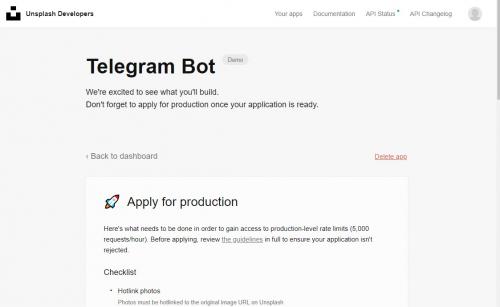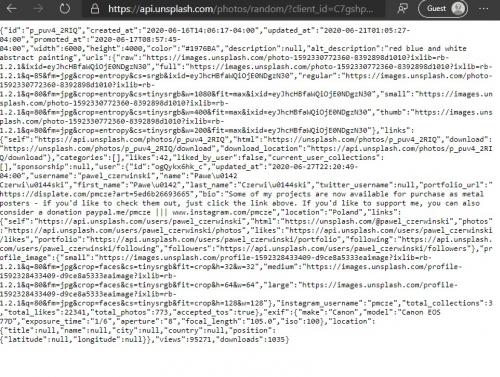Telegram бот на python3. Building simple Telegram Bot in Python
Telegram бот на python3. Building simple Telegram Bot in Python
Telegram can be used for chatops using the extensive Bot API provided.Its user base,availability of mobile and web app support makes it good candidate for personal and small business use,if not enterprise.
- Visit Unsplash Developer page
- Register and request API key for your account.
Interestingly Telegram provides us an official Bot BotFather to request our Bot creation.Open the link in Telegram and request your Bot.

Request Unsplash API key
With the Bot now available we need Unsplash API key for our Bot to access and request images.The procedure is simple.

Additonal documentation on using API is available here
Install dependencies
With Telegram Bot and Unsplash API key its now time to prepare your Python environment.Install the Telegram Bot library using
Main Program

Below is the sample program to create a Bot.I have updated the script in the source to use latest Bot API.
##Libraries need for the Bot from telegram.ext import Updater , InlineQueryHandler , CommandHandler , CallbackContext from telegram import Update , Bot import requests import re ##Function to fetch the image from the Unsplash API def get_url (): contents = requests .
Using Bot
We are now ready to use our Bot.
- Run the Python script above.
- Start conversation with our Bot from Mobile or Web.
- Send /pic as message
- The Bot responds with random image.
Congrats you have built your first usable Telegram Bot.

What’s Missing
You might have started noticing the limitations in your script and Bot,the availability,memory usage,timeouts etc.
To overcome the same,we need to
- Design and run the Python requests as a service and Flask is best choice.
- Host the service on a dedicated Server or cloud to make it available and scale.
Conclusion
This was a simple exercise to create a Telegram Bot and to show its capability.You can extend this to create a chatbot which can serve as your personal assistant.
Telegram-bot Python github. Telegram bot framework
This repository contains a Python framework to build bots against the.
The framework is event-based where you can configure what actions to perform when certain events occur (eg. someone enters a group, a command is sent to the bot, etc.).
You can find inan already-configured bot using this framework.
The framework works only on a Python 3 interpreter. There are no plans to support Python 2, which will be.
Set-up your own bot using this framework
- Someone enters a group
- A command is sent to the bot
- ...
Install
This repository contains a Python framework to build bots against the Telegram platform.
Event-Based Framework
The framework is event-based, allowing you to configure what actions to perform when certain events occur, such as:
Pre-Configured Bots
You can find an already-configured bot using this framework.
System Requirements
The framework works only on a Python 3 interpreter.
There are no plans to support Python 2, which will be.
Installation
Install the framework using pip:
pip install telegram-bot-framework
For more information, please refer to the README file.
or add install_requiresin yoursetup.py, or to yourrequirements.txtfile.
Create aconfig/dir in the base directory of your bot and add the configuration options specified in theto it.
Copy the main.py and bot/manager.py files to your bot directory. Updatemain.pyto use your newBotManagerclass instead of the framework one. Launchmain.py. You now have a working bot with many features out-of-the-box! Configure them (to remove the ones you do not want, and add yours) in themanager.pyfile.
- You can also copy run.sh and use it as the launcher script for your bot. It performs some initialization tasks before running the bot, creates a virtual environment to install the dependencies and run the bot on it, re-executes the bot if it crashes, and updates your VCS before running.
OPTIONAL To enable i18n support, copy the locales dir to your bot base directory, and run itsgenerate_mo.shscript (therun.shscript will do it for you if you are using it). Use thelocales/dir as the base dir for your translations. You can use and modify the helper scriptupdate_po.shto extract.pofiles from your code.
Python-telegram-bot примеры. Самый простой бот
Сперва глянем внашего базового пакета, чтобы понять, с чего начинается простенький бот. Следующий код
# -*- coding: utf-8 -*-
from telegram.ext import Updater # пакет называется python-telegram-bot, но Python-
from telegram.ext import CommandHandler # модуль почему-то просто telegram ¯\_(ツ)_/¯
def start(bot, update):
# подробнее об объекте update: https://core.telegram.org/bots/api#update
bot.sendMessage(chat_id=update.message.chat_id, text="Здравствуйте.")
updater = Updater(token='TOKEN') # тут токен, который выдал вам Ботский Отец!
start_handler = CommandHandler('start', start) # этот обработчик реагирует
# только на команду /start
updater.dispatcher.add_handler(start_handler) # регистрируем в госреестре обработчиков
updater.start_polling() # поехали!
/start) и многозначительно молчит при любых последующих действиях с вашей стороны.Соответственно, если мы захотим повесить обработчики любых текстовых сообщений или любых команд, нам нужно будет написатьfrom telegram.ext import Filters, MessageHandler
def handle_text(bot, update):
# …
def handle_command(bot, update):
# …
# MessageHandler -- более универсальный обработчик, который берёт на вход фильтр
text_handler = MessageHandler(Filters.text, self.handle_text)
command_handler = MessageHandler(Filters.command, self.handle_command)
# регистрируем свеженькие обработчики в диспетчере
updater.dispatcher.add_handler(text_handler) # без регистрации будет работать,
updater.dispatcher.add_handler(command_handler) # но не больше трёх месяцев (шутка)
yield.Готовый чат-бот на Python. Поиск ближайших соседей
В предыдущих разделах мы закачали в python корпус диалогов, векторизовали его, и сократили размерность, а теперь хотим наконец научиться искать в нашем 300-мерном пространстве ближайших соседей и наконец-то осмысленно отвечать на вопросы.Поскольку научились отображать вопросы в Евклидово пространство не очень высокой размерности, поиск соседей в нём можно осуществлять довольно быстро. Мы воспользуемся уже готовым алгоритмом поиска соседей. Но мы напишем свою модель-обёртку, которая выбирала бы одного из k ближайших соседей, причём чем ближе сосед, тем выше вероятность его выбора. Ибо брать всегда одного самого близкого соседа — скучно, но не завязываться на сходство совсем — опасно.Поэтому мы хотим превратить найденные расстояния от запроса до текстов-эталонов в вероятности выбора этих текстов. Для этого можно использовать функцию softmax, которая ещё часто стоит на выходе из нейросетей. Она превращает свои аргументы в набор неотрицательных чисел, сумма которых равна 1 — как раз то, что нам нужно. Дальше полученные «вероятности» мы можем использовать для случайного выбора ответа.Фразы, которые будет вводить пользователь, надо пропускать через все три алгоритма — векторизатор, метод главных компонент, и алгоритм выбора ответа. Чтобы писать меньше кода, можно связать их в единую цепочку (pipeline), применяющую алгоритмы последовательно.В результате мы получили алгоритм, который по вопросу пользователя способен найти похожий на него вопрос и выдать ответ на него. И иногда это ответы даже звучат почти осмысленно.
Телеграм бот для приема заказов Python. Зачем нужна оплата?
В жизни каждого разработчика телеграм ботов наступает момент, когда необходимо реализовать оплату в вашем боте. И тут у вас есть два пути. Первый — зарегистрировать ИНН, ИП/Юридическое лицо и подключить официальную оплату от телеграма или просто использовать сторонний сервис по типу Free-Kassa, QIWI и т.д. Думаю выбор очевиден, в этой статье я буду использовать QIWI, потому что так хочу.Для начала давайте подумаем как бот будет проверять что пришло, от кого и какая сумма. Капитан очевидность подсказывает мне, что необходимо будет получить всю историю переводов на аккаунт, который мы будем использовать в качестве нашего счета для приема платежей. Давайте это сделаем:
import requests
import json
QIWI_TOKEN = ''
QIWI_ACCOUNT = ''
s = requests.Session()
s.headers = 'Bearer ' + QIWI_TOKEN
parameters = {'rows': '50'}
h = s.get('https://edge.qiwi.com/payment-history/v1/persons/'+ QIWI_ACCOUNT +'/payments', params = parameters)
req = json.loads(h.text)
- Генерируем рандомное число от 100000 до 999999.
- Временно заносим данные в таблицу (id пользователя, номер телефона, сумма, сгенерированное ранее рандомное число) req.
- Добавляем свой функционал после оплаты…
import sqlite3
c.execute("CREATE TABLE IF NOT EXISTS payment_query(user_id INTEGER, phone TEXT, sum INTEGER, code INTEGER)")
from random import randint
# создаем иссуственные данные, которые хотим проверить
phone = '+79999999999'
sum = 100
random_code = randint(100000, 999999)
c.execute(f"INSERT INTO payment_query VALUES({message.from_user.id}, {phone}, {sum}, {random_code})")
conn.commit()